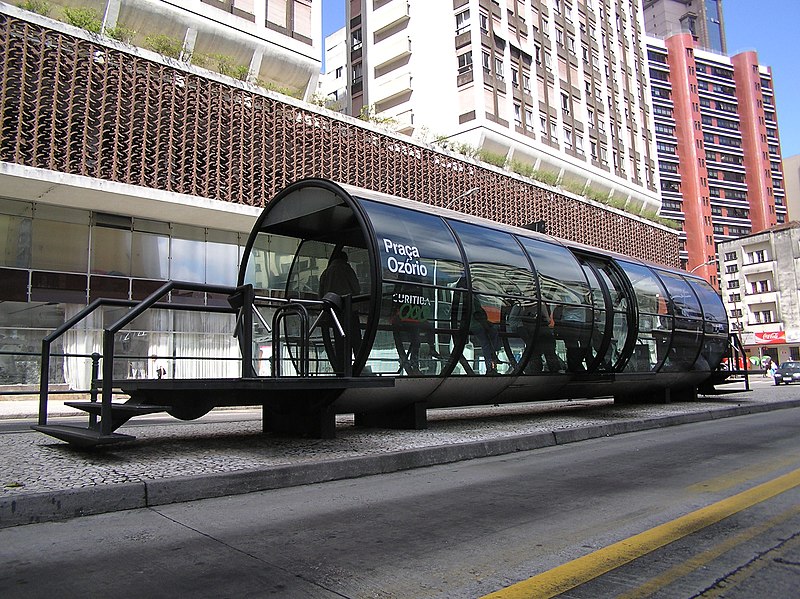how long...
 ...will it take to improve the quality of life in Metro Manila? Decades?
...will it take to improve the quality of life in Metro Manila? Decades?
Try 3-4 years. That's according to Jaime Lernier, the the former (and famous) three-time mayor of the city of Curitiba, the capital of the Brazilian state of Parana. (He later became governor of Parana.)
Lernier, speaking last week at the World Watch Institute's State of the World 2007 briefing here in D.C., said “Every city can improve its quality of life in 3 to 4 years.”
How? Through "urban accupuncture" -that is, by "tackling urban problems at appropriate 'pressure points' (that) can cause positive ripple effects throughout entire communities."
Lerner noted that even the poorest cities can boost their standards of living by using techniques like bus rapid transit (BRT), designing multiuse buildings, and encouraging residents to live closer to their workplaces.Lernier should know what he is talking about, he not only pioneered the Bus Rapid Transit system, he also pioneered innovative city maintenance systems such as:
- using herds of sheep instead of tractors to keep the grass in the city parks -saving the city millions in mowing costs
- paying fishermen to collect garbage (by the pound) from the neighboring bay -cleaning the bay in no time while giving the fishermen income year round and saving the city millions in clean-up and maintenance costs
- trading bags of groceries and transit passes to people in slums in return for bags of garbage (cleaning up the streets in the slums which were too narrow for garbage trucks to get into)
More after the jump...
Lernier started planning and building Curitiba's Rede Integrada de Transporte in the 70's after doing a cost analysis that showed:
...that "heavy rail" like a subway costs ten times the amount for "light rail" (trolleys), which, in turn, costs ten times a bus system, even with dedicated bus ways. The "light rail" savings usually touted to sway municipal decision makers occur because even trolleys can have relatively fewer drivers than a 40 - 60 passenger bus. Lerner got Volvo to make 270-person accordion buses (300 Brazilians, says Lerner), so that was no longer an issue. The City built attractive transit stops with the look and feel of train stations -- and all the handicapped access equipment -- and got private firms to purchase and operate the buses. The city controls the routes and fares, while the private companies hire drivers and maintain equipment. (Emphasis mine-udc.)The success of the BRT inspired Bogota's Transmilenio, Mexico City's MetroBus, Jakarta's TransJakarta Busway and a dozen other BRT projects around the world). The system was cheap, easy to roll out and easy to use:
Curitiba has a very simple and practical transportation system. Public transportation consists entirely of buses. There are several different types of bus, each with a different function.At the Worldwatch Institute event, Lerner also encouraged:
Moving around in a car can be difficult in and around the city centre because of the many one-way streets and constant traffic jams. This makes the public transportation system more attractive if one wants to go there. (Emphasis mine -udc.) The trinary system allows quick access to the city centre for car drivers. Some avenues are spacious and laid out in a grid, and apart from some points around the city centre, Munhoz da Rocha Street and Batel Avenue, traffic jams aren't thus severe.
"greater efforts to turn chronic urban problems into innovative solutions. Curitiba, for example, converted an old landfill into the Open University for the Environment, a school that provides environmental education to citizens and policymakers at little-to-no cost. “In the city, there is no frog that can’t be turned into a prince,” Lerner says.From wikipedia: "In June 1996, the chairman of the Habitat II summit of mayors and urban planners in Istanbul praised Curitiba as "the most innovative city in the world."
(Btw, Lernier is an architect and an urban planner. His work as mayor of Curitiba and his continuing commitment to improving the urban environment is the kind of action i'd like to see from Filipino architects.)

No comments:
Post a Comment